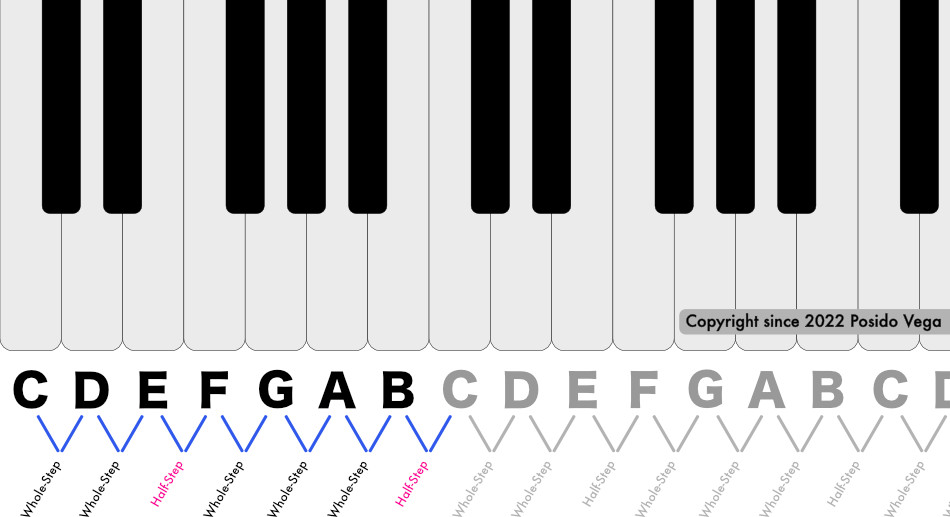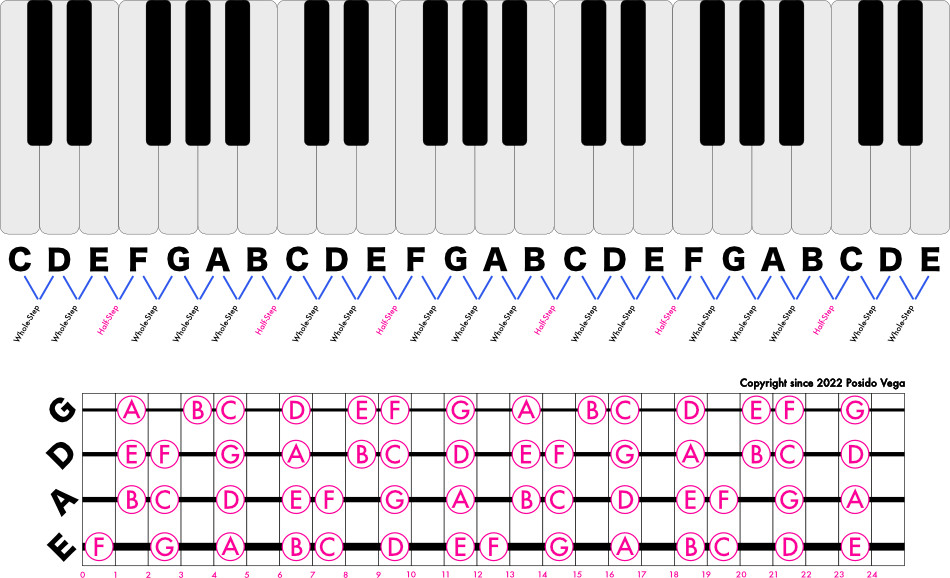Learning the notes on your bass guitar is fundamental to becoming a proficient bassist. Many players, even those with years of experience, sometimes struggle to confidently navigate the fretboard. But understanding where each note lies doesn’t have to be a daunting task. In fact, with the right approach, mastering your bass guitar notes can be achieved much faster than you might think.
The beauty of the bass fretboard lies in its inherent logic. Once you grasp this underlying system, the fretboard will become less of a mystery and more of a musical playground.
In this guide, we will explore: A step-by-step method to learn all your bass guitar notes efficiently, empowering you to confidently play and navigate your instrument.
Let’s dive in and unravel the fretboard!
Your 4-Step System to Mastering Bass Guitar Notes
The method I’ve developed to learn every single note on the bass fretboard boils down to these four straightforward steps:
We’ll break down each step in detail, accompanied by diagrams and explanations to ensure clarity.
For easy access, bookmark this page as your go-to resource, whether you’re a beginner just starting your fretboard journey or seeking to solidify your note knowledge.
Step 1: Understanding the Interval Logic of Musical Notes
Western music, in most genres, operates within a system of just 12 distinct notes. The key to quickly learning these notes is understanding the logical order in which they are arranged – one note at a time.
Pro Tip: Musical notes follow alphabetical order, from A to G. If you know your alphabet, specifically A through G, you already have a significant head start.
The notes A, B, C, D, E, F, and G are the foundation. These are known as natural notes and correspond to the white keys on a piano.
This sequence repeats endlessly: A, B, C, D, E, F, G, A, B, C, D, E, F, G, and so on. This pattern is consistent across all instruments.
The remaining five notes are the sharps and flats: A♯/B♭, C♯/D♭, D♯/E♭, F♯/G♭, and G♯/A♭. These notes are represented by the black keys on a piano, positioned between the natural notes.
You’ll notice that sharps and flats have dual names, a concept called enharmonic spelling.
While a note’s pitch remains the same, its spelling can vary depending on the musical context. However, when you’re first learning your fretboard, focusing on context isn’t crucial. Once you have a solid grasp of the fretboard, understanding when to use sharps or flats will come naturally.
Whole Steps and Half Steps Explained
Observe a piano keyboard and you’ll see black keys separating most white keys, with two exceptions.
Pro Tip: There is no black key between E and F, and no black key between B and C. This rule applies directly to the bass fretboard as well!
 Piano keys illustrating whole and half steps
Piano keys illustrating whole and half steps
Alt text: Piano keyboard diagram showing whole step and half step intervals between notes, highlighting E-F and B-C half steps.
The distance between E and F is always a half step (one fret). Similarly, the distance between B and C is always a half step (one fret).
All other natural notes are separated by a whole step (two frets).
Now, let’s apply this knowledge directly to the bass fretboard. The method I’m about to show you is far more efficient than simply memorizing notes one by one.
Step 2: Decoding the Logic of the Bass Guitar Fretboard
In Step 1, we established that:
- Musical notes are alphabetically ordered.
- E-F and B-C are always a half step apart.
- All other natural notes are a whole step (2 frets) apart.
Here’s the most vital piece of fretboard logic you need to understand:
- Each fret on your bass fretboard represents a half step.
- Two frets equal a whole step.
On a standard four-string bass guitar, the open string notes.) are E, A, D, and G, from thickest to thinnest string.
 Diagram of bass fretboard and piano notes correspondence
Diagram of bass fretboard and piano notes correspondence
Alt text: Bass guitar fretboard diagram correlating fret positions to musical notes and piano keys, illustrating note placement on the bass.
To learn your bass guitar notes effectively, start with one string at a time, beginning with the lowest, E string.
Remember the half-step relationships: E-F and B-C are the only natural note pairs without an intervening note.
Effortlessly Find the Notes on Your E-String
Starting with your E-string, the first fret is F.
Applying the musical note logic we’ve learned, we can find all the natural notes on the E string:
- Two frets up from F is G.
- Two frets up from G is A.
- Two frets up from A is B.
- One fret up from B is C.
- Two frets up from C is D.
- Two frets up from D is E.
- The pattern then repeats.
Let’s apply this same logic to the next string, the A-string.
Effortlessly Find the Notes on Your A-String
The note locations on the A-string follow the same pattern:
- Two frets up from A is B.
- One fret up from B is C.
- Two frets up from C is D.
- Two frets up from D is E.
- One fret up from E is F.
- Two frets up from F is G.
- Two frets up from G is A.
- And again, the pattern repeats.
Let’s continue this process and map out the natural notes on the D-string.
Effortlessly Find the Notes on Your D-String
The note locations on the D-string are as follows:
- Two frets up from D is E.
- One fret up from E is F.
- Two frets up from F is G.
- Two frets up from G is A.
- Two frets up from A is B.
- One fret up from B is C.
- Two frets up from C is D.
- The repeating pattern continues.
Just one more string to go! Let’s learn the bass guitar notes on the G-string.
Effortlessly Find the Notes on Your G-String
The note locations on the G-string are:
- Two frets up from G is A.
- Two frets up from A is B.
- One fret up from B is C.
- Two frets up from C is D.
- Two frets up from D is E.
- One fret up from E is F.
- Two frets up from F is G.
- The pattern repeats itself here as well.
Now that we’ve covered individual strings, let’s accelerate our learning by exploring octaves!
Step 3: Mastering Octave Shapes on the Fretboard
This step is vital for significantly speeding up your fretboard knowledge. Octaves act as landmarks across the fretboard. While other intervals, like fifths, can also serve this purpose, octaves are particularly helpful for beginners because they represent the exact same note at a higher or lower pitch, making them less conceptually confusing.
A perfect octave is a note with double the frequency of another.
Octaves exist in many places on your bass guitar fretboard, and learning to recognize these patterns is key.
Locate all the octaves across your bass neck.
Alt text: Bass fretboard diagram illustrating various octave shapes and patterns across the neck, aiding in fretboard navigation.
Here are some easy-to-remember octave shapes:
- Move two frets higher and up two strings to find an octave higher.
- Move two frets lower and down two strings to find an octave lower.
- Move three frets lower and up three strings to find an octave higher.
- Move three frets higher and down three strings to find an octave lower.
- Move five frets lower and up one string to find an octave higher.
- Move five frets higher and down one string to find an octave lower.
- Move seven frets higher and up one string to find an octave higher.
- Move seven frets lower and down one string to find an octave lower.
Step 4: Applying Your Knowledge in Musical Contexts (Fretboard Mastery Fast Track!)
While the first three steps provide the foundational knowledge of bass guitar notes, it’s Step 4 – applying this logic and using octaves as reference points – that will truly accelerate your fretboard mastery.
Pro Tip: There’s no shortcut here. You need to play your bass and actively practice applying what you’ve learned.
The more you practice, the more ingrained the notes will become, and fretboard navigation will become second nature faster than you anticipate.
In the video mentioned earlier, I demonstrate how to apply these concepts using a simple bass line and a metronome for timing. When playing a root note, consciously think about the location of its octave and then play the same bass line an octave higher.
You’ll quickly realize how easy it becomes to pinpoint notes across the fretboard.
(Bonus) Step 5: Verbalize Note Names During Practice
During every practice session, dedicate a few minutes to consciously saying the name of each note aloud as you play it.
Practice slowly and deliberately.
Prioritize accuracy over speed in this exercise.
This technique is incredibly effective for rapidly learning all the notes on the bass. A method I personally used was to say the note name, locate the fret, and then play the note. When I was learning to read standard music notation, verbally reciting note names reinforced their positions on the fretboard.
I even incorporated this into band rehearsals, jam sessions, and live performances. This way, I was learning and reinforcing note knowledge while playing in real-time.
This practice forced me to think on my feet and significantly boosted my confidence, especially when I was starting out on the bass.
Your Turn to Play
All the knowledge about fretboard logic and octaves is valuable, but its true worth unfolds when you put it into practice.
Learning your bass guitar notes is indispensable for improvisation, reading music, and playing along to chord charts while maintaining solid timing.
So, start applying what you’ve learned today, and you’ll witness tangible progress in just a few weeks.
For more resources and content to enhance your bass playing journey, explore My Sandbox.
Frequently Asked Questions
What are the Notes on a Bass Guitar? (Standard Tuning)
On a standard 4-string bass guitar, the strings are tuned to the notes E, A, D, and G.
For a 5-string bass, the string notes are B, E, A, D, and G.
For a 6-string bass, the string notes are B, E, A, D, G, and C.
Standard bass tuning is in fourths. Understanding fourth intervals, similar to octaves, provides another valuable pattern for learning notes across strings.
What’s the Most Effective Way to Memorize Bass Guitar Notes?
A common question I encounter is, “How do you memorize the notes on the bass?”
My response is consistently, “You don’t, not primarily.”
It’s far more beneficial to understand the underlying logic of note spellings and the fretboard layout. Once you grasp these principles, the note locations on the neck become intuitive and logical.
Develop good habits like recognizing patterns and shapes, and verbally naming notes as you play. Trust the learning process.
Memorization will occur naturally as you establish connections and find meaning in the information you’re learning. Recognizing patterns and shapes is a powerful way to build these mental connections.
How Do You Find Notes on the Bass Guitar?
To find notes on the bass guitar, you must understand the instrument’s fretboard. A 4-string bass in standard tuning has strings E, A, D, and G. The fretboard layout mirrors a piano. Natural notes are a whole step apart, except for E-F (half step) and B-C (half step). All other natural notes are a whole step apart.
